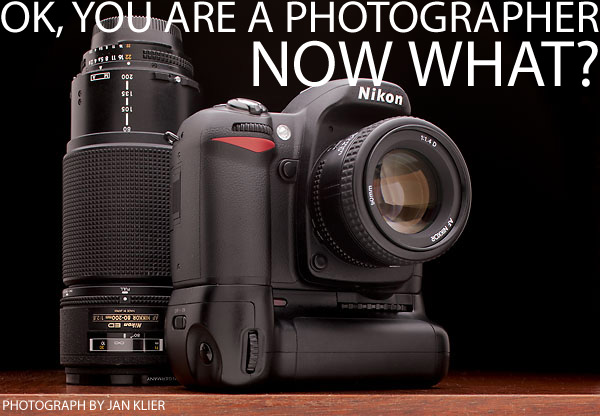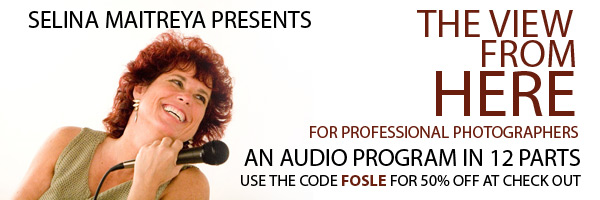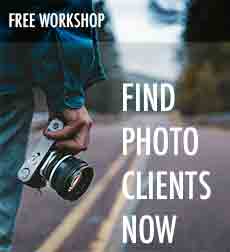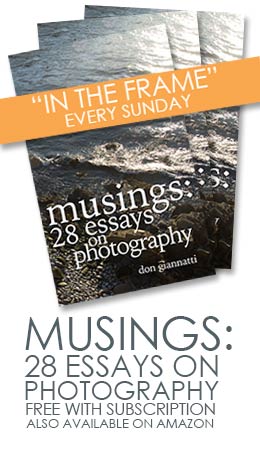
OK… today’s the day. You left your day job behind as planned, or are now “free to seek new positions” due to situations you had no control over. And now you are a photographer. What does that mean to you? What do you see in your minds eye as you doing what you love. Is it a new Ferrari with you at the wheel with a couple of supermodels at your side heading off to the French coastline for another cover of Vogue whileon the cell phone to make sure all your villas are stocked with the perfect wines? (Scuse, me – laughing too hard right now… OK, better now.) Or is it doing what you love to do in the surroundings you would love to work in? If you don’t know what that looks like, you need to do some personal asset research as well as some visualization.
I am a big believer in visualization: both as a photographer and as a person. We get what we focus on – concentrate on, and we can only get that when we know and see what that is. In our mind. Visualizing what success looks like for you has two advantages: First, it lets the brain know what you are looking for, and second it lets you know when you are arriving at that point. Keep moving, but knowing where you are is terribly important.
For this post you will need a notebook. That’s a flat thing with paper all stuck at the top? Some of them are yellow with lines? OK, you can do it on your iBerrypad thing if you want. But the power of writing is very important.
1. What would you shoot if you could shoot any subject that you wanted?
Yeah, that’s right. If you were to tell me what you do, what would it be? Fashion? Architecture? Interiors and landscapes? What?
If this afternoon you had a gig, and it was a gig within the genre you have identified, what would it look like? Lots of assistants and stylists and models running all over with the rock music blaring and all eyes on you, or a quiet sunset atop a lonely peak in some mountain range in Chile? Is it the solitude of a quiet studio working on shots of food or still-life? Is it waiting till the light is just right on a new building to get ‘the’ shot of it for an architect?
Whatever it is, it is vitally important to get a picture of the work you want to do firmly planted in the brain. Visualization of your working life can have the benefit of helping you achieve the kind of work you want to do. Making sure you consistently follow the path that will lead you to that kind of work is the brain’s job. Help it by showing and telling it what you want.
Got that notebook I asked you to grab? Good. Write down what you want to shoot. What your environment on a typical shoot would look like. Don’t worry about grammar or punctuation. Wtevr U do will b gd if U can read it.
2. Do you have a list of 20 possible clients for the kind of work you want to do?
So now we have identified your subject matter and the kind of work you want to do. Now… who in your area pays for that kind of work? I know we need more than 20 possibles to do any kind of marketing, but this is a very important exercise and one I am constantly amazed by. I meet photographers with plans of ‘making it’ and they have no idea who would pay them for the work they want to do.
That is not a good business plan.
Let’s say you want to be an architectural photographer in your mid-sized city of 900,000. Who in that city would buy architecture photographs?
1. YourCity Magazine
2. Architects
Uhh…
Many times that is where we stop. That is not enough.
Let’s dig some more:
3. Interior Designer / Interior Decorators (not the same)
4. The construction companies that are building/have built the buildings
5. The suppliers to the construction companies
6. Landscape designers
7. Landscape contractors
8. Lighting designers
9. Lighting product suppliers/contractors
10. The City
11. The City Historical Society
12. The City Library
13. City Hall
14. Local Hotels / National Hotels with Hotels in your city
15. Restaurants / Clubs
16. Retail Store Designers
17. Tenant Improvement Contractors
18. The Mall
19. Regional Magazines
20. Travel Magazines
Well, that looks a lot better. That looks like you could make a living working with all of those types of clients. And the ones we didn’t identify will stretch that list even more. Within each one of many on the list are lists of their own… restaurants alone could be a huge list. Now the work goes into identifying who it is that hires the photographer to make the restaurant photographs. (Hint, it isn’t the girl taking orders at the register, so dig deeper than that.)
Notebook? Pen? We’ll still be here when you get back. There is more after the jump:
3. Who are the current tops of their game in that genre?
OK, so you have identified the genre you would absolutely love to be a ‘top dog’ in. And we have a list of possible clients for our work. Now we need to know who is currently serving that market. (No, we aren’t heading over to slash his tires or set up harassing websites to put her out of business… hmmm, just thought of an interesting web project… but I digress.) We need to know who they are so we can identify what makes us different. A competitive analysis is not a bad thing, and businesses do it all the time.
You have to be different. Your USP as they refer to it, your Unique Selling Proposition is what sets you apart. Another clone of the current ‘big dog’ is not needed. And we are not going to be trying to ‘undercut’ them either, this is not like selling lemonade on the corner. We set our rates to be within the established rates and can be competitive, for sure, but I am not wanting anyone to do a rate war on anyone else. Silly and all it does is drive all of it into the toilet.
But you can see their style, and how they deliver their work. You can discover their reputation of being ______ and you will maybe find a way to make yourself ________. If your styles are identical, work at adding something to your work. There is no room for ‘gudnuff’ any more, so your work has to be top notch. It has to be impeccable, and you have to present yourself as someone who does something different than the clients current choice of shooter.
Notebook: You can work on this part later, as it will take some time and research. Sorry, there simply is no easy way to do it.

4. What have you identified as being the most valuable assets to doing the kind of work you want to do?
Ahh, this one is a bit tricky. It involves gear, attitude and personal situations.
Let’s say you want to shoot portraits. For editorial and advertising.
Now after doing number 2 and three above we have a list of possible clients, and an idea of who the major players are. (We also already have a portfolio, right? I mean you didn’t wake up this morning wanting to do something you have never done… did you. OK, well if you did, you will need to add some portfolio shooting to preface this whole thing. Sorry.) So you know you like photographing people, and have most of the gear to get it done.
But do you have all the redundancy to get it done. When on assignment it is different than putting one’s portfolio together or doing personal work. You may only have a subject for 20 minutes, and they may NEVER be available to you again. Multiple cameras, backup lights, enough lenses to take care of any problems. Tethered shooting gear if possible. Redundant redundancies on storage and archiving. Enough stands and clamps and scrims and boxes to make your shot… without having to run to the ______.
So you have to be able to work under pressure, sometimes extreme pressure of deadlines, press secretaries, bad locations, cranky subjects, difficult editors… and more. Lots more. And it isn’t so much that you can work under pressure, I think it is that the pressure is part of the work. It feeds you and pushes you to limits you didn’t know you had – and beyond.
It is also hard to have a ‘life’ like the neighbors. Travel, late night flights, missed birthdays, anniversaries and even births… it happens. Scheduling anything personal more than a week or two out can be a waste of time. An understanding and supportive partner is so incredibly important. If they are not, that stress can be a real career killer.
Notebook: What are your personal assets for doing this kind of work? What do you need to work on? If there is gear to buy, what do you need to get comfortable? What about your personal situation? Will this work? If not, what can you do to make it so life away from the camera is fun instead of a living hell. Trust me, I have seen this in person. My wife has supported my working for over thirty years, missed vacations and lean times included. Here’s hoping you fare as well.
5. What are the challenges you face in doing what you want to do?
Well, we got what you want to do, a list of at least 20 possible areas to sell in and an asset list of what we have to work on. We now know what we need to do to set ourselves apart from the competition and we are getting after it.
Do you have a plan? What you are going to do Monday, Tuesday, May, next year?
Planning makes it easier. If you work the phones for an hour a day you are miles beyond most of your competition, I guarandamntee that. If you work the book, getting it into the hands of possible buyers once a week, you are way above the competition. And if you market at all… steadily, you are in maybe the top 5% of the photographers who say they want it really really bad and will get after it just as soon as they get someone ‘whacked’ on Mafia Wars… or some other timesuckingbullshit that is designed to waste your time.
Set your google calendar, paper calendar or whatever you want. Call and show, call and show. Get with Constant Contact and develop a list to keep people apprised of your new work (Geeezzz, we don’t have to go into how important it is to constantly add new images to your portfolio do we? Good.) There are great list houses out there that will help you narrow down a focused set of names/addresses/emails for you to work. Now work them.
There are lots of changes out there. And there are lots of people who will tell you it is a terrible time to start a business in photography. Yeah, they’re right. They are always right. When is it a ‘good time’ to start any business? When things are booming, everyone is starting and the competition is heavy. When it is slow, then there’s no work they say. Whine and play Farmville. Whine and tweet about how it sucks all day. Good, that just clears the road for you.
Screw ’em. This is a fabulous time to start a business. Expectations are low, entry is based on how the hell hard you want to work. And your talent has a chance to be a deciding factor.
I am asked what it takes to be successful as a commercial photographer and my answer has always been:
1. Make ungodly incredible kickass freakin’ pictures
2. Show them to an ungodly amount of people who appreciate your incredible kickass pictures.
That’s about it.
Hey, thanks for joining me on this little Rant today. I occasionally puff and rant a bit on Twitter and you can follow me if you like. If you would like to spend two days at an incredible photography workshop, take a look at Learn to Light. We have scheduled a lot of cool places that other workshops don’t necessarily go.





I think that this is a great exercise, and I completely agree with your attitude and comments in part 5. Really, it takes motivation and effort to make it as a freelancer or self-made businessperson. And that applies to any field, not just photography.
Great article. Thanks. I am standing at the edge trying to work up the guts to jump, this stuff helps so much.
Don,
I have been following your site for a long time. I am not a pro, but am planning to be. That’s what started me on a search for knowledge.
I was a musician in my earlier years, then changed careers. My current career very much requires me to have a good understanding of what is involved in running a business. Anyway, I now know that as a musician I needed this sort of advice but didn’t get it. I know now that even if I did I wouldn’t have got it. You have to be in the right ‘place’. My experience was that some thought (think) that ‘business’ is a dirty word and has no place in ‘art’. Now that I am older/wiser(?) these things your discussing -from working hard, to practising, to publishing only your best work, to having the ‘elevator speech’ is a critical. These things are a must for any business and photography (like music) is a business like any other. It requires skills and knowledge that aren’t part of the ‘art’ and that is something that is rarely discussed.
I just wanted to say thanks for your your articles and maybe someday you can come down to Australia and do some workshops -both the art and the business!
Cheers.
John
You are welcome, John.
We are looking into a New Zealand/Australia workshop for your summer.
Don,
That’s fantastic news about the workshops in Australia! Please keep John & myself posted. I’ve been reading your LE posts for a couple of months now and they always serve to lighten the road ahead for me. I’m currently working a 9-5 that I no longer respect and I suspect this has gone on for a long time with all the 9-5’s I’ve worked as I’ve never decided on a career path until I got knocked my photography up a gear a little over a year ago.
All of a sudden my photography was giving me images that I hadn’t seen since I started learning and shooting in ’93-94! I made a dicision before Christmas last year that my photography was at the stage where it could provide for me if I knew how the business worked. Your blog posts among a few have helped me see where I need to go and how to constantly fine tune how I need to get there. I’ve got 14 months to arrive at a point where I can decide on going full time and you’re one of the people I need to thank.
Regards,
Alex
Great article. I firmly believe in visualization. I ski raced when I was in High School and I would visualize every inch of the course in my head and then put myself in that course.
This works in all walks of life. I really appreciate all your advice as it gets me moving forward. I am “now “free to seek new positions†due to situations I had no control over” and turning my love into a new career pursuit. Every time I get in a rut I read your advice and march forward.
Your workshops are great and I can’t wait to hit another one!!
When people ask me about sales, I tell them that there are two things that MUST be done in order to generate new leads and convert them into sales: ALWAYS BE PROSPECTING and ALWAYS BE CLOSING. I love that you highlight that approximately 95% of the competition ISN’T doing this.
I’ve never closed a client by adding them to my Mafia or having them as my neighbor on my Farm. If you want it, you have to go and get it – it’s certainly not going to fall in your lap.
Thanks for the great post Don.
Great and better: Useful post.
Thnx
Just got laid off three hours ago. Still trying to get my arms around this brand new world. I really appreciate the article. It will help me get focused on what I need to do. I go to my exit meeting tomorrw so the old employer can explain the benefits I have from be rifted.
I declare that I am a full time professional photographer. I just need a few paying clients, LOL.
Well. That officially sucks.
Contact me at my email – you will find it on the sites – and let me know a good time to talk/review your work.
Let’s get you going and working toward making some bucks.
Maybe we can get you on a fast track.